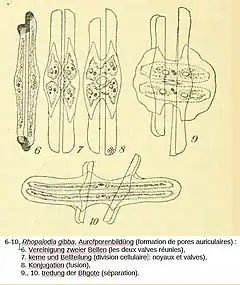Rhopalodiaceae
Les Rhopalodiaceae sont une famille d'algues de l'embranchement des Bacillariophyta (Diatomées), de la classe des Bacillariophyceae et de l’ordre des Rhopalodiales.
Rhopalodiaceae

Rhopalodia gibba.
| Empire | Eukaryota |
|---|---|
| Règne | Chromista |
| Embranchement | Bacillariophyta |
| Sous-embr. | Bacillariophytina |
| Classe | Bacillariophyceae |
| Sous-classe | Bacillariophycidae |
| Ordre | Rhopalodiales |
- Epithemiaceae Grunow, 1860[1]
Étymologie
Le nom de la famille vient du genre type Rhopalodia, dérivé du grec ῥόπαλον / rópalon, massue, en référence à la forme de la diatomée « club-to pear-shaped », c'est-à-dire dont la forme varie entre une massue et une poire[2].
Liste des genres
Selon AlgaeBase (12 juin 2022)[3] :
- Cystopleura Brébisson ex Kuntze, 1891
- Epithemia Kützing, 1844
- Katahiraia S.Komura, 1976
- Protokeelia C.W.Reimer & J.J.Lee, 1984
- Pyxidicula Ehrenberg, 1834
- Rhopalodia O.Müller, 1895 - genre type
- Tetralunata Hamsher, Graeff, Stepanek & Kociolek, 2014
- Thermocharis Ehrenberg, 1858
- Yoshidaia S.Komura, 1976
Systématique
La famille des Rhopalodiaceae a été créée en 1960 par les phycologues ukrainiens Aleksandr Viktorovitsj Topatsjevskiy (d) (1897-1975) et O. P. Oksiyuk (d) (fl. 1960)[3].
Publication originale
- (uk) A.V. Topachevs'kyj et O.P. Oksiyuk, Vyznachnyk prisnovodnykh vodorostei Ukrayinskoyi RSR. Vol. 11 Diatomovi vodorosti Bacillariophyta (Diatomeae) [« Clés d'identification des algues d'eau douce de la RSS d'Ukraine. Vol. 11 Diatomées Bacillariophyta (Diatomeae) »], Kiev, Fondation de l'Académie des sciences de la RSS d'Ukraine, , [1]-412.
Liens externes
- (en) Référence AlgaeBase : famille Rhopalodiaceae Topachevs'kyj & Oksiyuk, 1960 (consulté le )
- (en) Référence BioLib : Rhopalodiaceae (Karsten) Topachevs'kyj & Oksiyuk 1960 (consulté le )
- (fr+en) Référence EOL : Rhopalodiaceae (consulté le )
- (fr+en) Référence GBIF : Rhopalodiaceae (consulté le )
- (en) Référence IRMNG : Rhopalodiaceae (Karsten) Topachevs'kyj & Oksiyuk, 1960 (consulté le )
- (en) Référence OEPP : Rhopalodiaceae (consulté le )
- (en) Référence Paleobiology Database : Rhopalodiaceae (consulté le )
- (en) Référence The Taxonomicon : Rhopalodiaceae (Karsten) Topachevs'kyj & Oksiyuk (1960) (consulté le )
- (en) Référence World Register of Marine Species : taxon Rhopalodiaceae (Karsten) Topachevs'kyj & Oksiyuk, 1960 (+ liste espèces) (consulté le )
Notes et références
- Rees, T. (compiler). The Interim Register of Marine and Nonmarine Genera. Available from https://www.irmng.org at VLIZ, consulté le 4 juin 2022
- (en) Christine Cocquyti, Wolf-Henning Kusber et Regine Jahn, « Epithemia hirudiniformis and Related Taxa within the Subgenus Rhopalodiella subg. nov. in Comparison to Epithemia subg. Rhopalodia stat nov. (Bacillariophyceae) from East Africa », Cryptogamie Algologie, vol. 39, no 1, , p. 35-62 (ISSN 0181-1568 et 1776-0984, OCLC 06852829, DOI 10.7872/CRYA/V39.ISS1.2018.35)
- Guiry, M.D. & Guiry, G.M. AlgaeBase. World-wide electronic publication, National University of Ireland, Galway. https://www.algaebase.org, consulté le 12 juin 2022
Cet article est issu de wikipedia. Text licence: CC BY-SA 4.0, Des conditions supplémentaires peuvent s’appliquer aux fichiers multimédias.